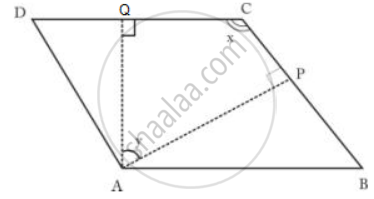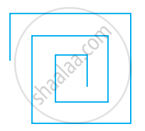Advertisements
Advertisements
प्रश्न
How many tiles, each of area 625 cm2, will be needed to pave a footpath which is 1 m wide and surrounds a grass plot of size 38 m x 14 m?
उत्तर
Area of grassy plot
= 38 x 14
= 532m2
Length of a grass plot with footpath = 38 + 2 = 40m
Width of a grass plot with footpath = 14 + 2 = 16m
∴ Area of the grass plot with footpath = 40 x 16 = 640m2
Area of the footpath = Area of the grass plot with footpath - Area of grassy plot
= (640 - 532)m2
= 180m2
= 1080000m2
Area of each title = 625cm2
∴ Number of titles
= `"Area of the footpath"/"Area of each title"`
= `(1080000)/(625)`
= 1728.
APPEARS IN
संबंधित प्रश्न
Diagonal AC of a parallelogram ABCD bisects ∠A (see the given figure). Show that
- It bisects ∠C also,
- ABCD is a rhombus

ABCD is a rectangle in which diagonal AC bisects ∠A as well as ∠C. Show that:
- ABCD is a square
- diagonal BD bisects ∠B as well as ∠D.
State, 'true' or 'false'
The diagonals of a rectangle bisect each other.
In parallelogram ABCD, AP and AQ are perpendiculars from the vertex of obtuse angle A as shown.
If ∠x: ∠y = 2: 1.
find angles of the parallelogram.
State, 'true' or 'false'
The diagonals of a quadrilateral bisect each other.
State, 'true' or 'false'
Diagonals of a rhombus are equal.
In a square ABCD, diagonals meet at O. P is a point on BC such that OB = BP.
Show that:
- ∠POC = `[ 22 ( 1°)/( 2 ) ]`
- ∠BDC = 2 ∠POC
- ∠BOP = 3 ∠CPO
In the given figure area of ∥ gm PQRS is 30 cm2. Find the height of ∥ gm PQFE if PQ = 6 cm.
A quadrilateral ABCD is such that diagonals BD divides its area into two equal parts. Prove that BD bisects AC.
In the given figure, BC ∥ DE.
(a) If area of ΔADC is 20 sq. units, find the area of ΔAEB.
(b) If the area of ΔBFD is 8 square units, find the area of ΔCEF
Find the area of a parallelogram whose base is 12cm and the height is 5cm.
Two adjacent sides of a parallelogram are 34 cm and 20 cm. If one of its diagonal is 42 cm, find: distance between its shorter sides
One side of a parallelogram is 12cm and the altitude corresponding to i is 8cm. If the length of the altitude corresponding to its adjacent side is 16cm, find the length of the adjacent side.
Find the area of a square whose diagonal is `12sqrt(12)"cm"`
Find the area of a rhombus, whose one side and one diagonal measure 20cm and 24cm respectively.
Diagonals of a rectangle are equal and perpendicular. Is this statement true? Give reason for your answer.
The diagonals of a square are perpendicular to one another.
Give reason for the following :
Squares, rectangles, parallelograms are all quadrilaterals.
A figure is said to be regular if its sides are equal in length and angles are equal in measure. Can you identify the regular quadrilateral?
Examine whether the following is a polygon. If it is not, say why?

